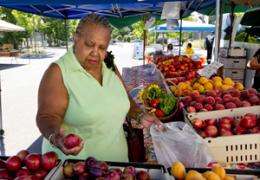Mobile devices help remove barriers to fresh food

It’s just a third of a mile from the East Palo Alto farmers’ market to Runnymede Garden Apartments — the city’s only housing facility for seniors and adults with disabilities — but to the building’s residents, it might as well be a trek up Mount Everest.
Conditions can be challenging for those using wheelchairs or walkers, with a trip to the market requiring residents to travel down a busy street, and to navigate around sidewalks blocked by parked cars, poorly lit streets and a crosswalk light too brief for them to cross the four-lane intersection.
These physical barriers to fresh-food sources are often overlooked by city planners, said Matthew Buman, PhD, a postdoctoral scholar and the Sandra Jane Winter, PhD, Research Assistant at the Stanford Prevention Research Center, after the center’s Active Aging Studies team conducted an audit of 40 senior housing facilities in Northern California.
This inspired the team to find a better way to alert city officials about these environmental obstacles. And this better way is the “Stanford Healthy Neighborhood Tool,” a software application that allows community advocates wielding smartphones and tablet computers to document impediments to walkability, safety and healthful-food access.
This is one of several healthy-aging studies being spearheaded by Abby King, PhD, professor of health research and policy and of medicine, who is bringing together experts in community health, psychology, design and engineering to explore how mobile devices and communication technologies can be used to get seniors off the couch and into their community to exercise, shop, garden and socialize.
This new Stanford app allows community health advocates to walk around a neighborhood, take a picture of a hazard using a mobile device’s built-in camera, then make a voice recording explaining the hazard. Once a picture is taken, the app records the hazard’s precise location using the built-in GPS. Instantly, all the hazard photos and locations can be downloaded wirelessly to a map on a website, so they can be shared with researchers, city planners or policymakers.
“It’s all about empowering seniors to improve their own neighborhoods and to educate city officials about what’s important to them,” said Buman. “By having concerned residents talking about these problems, it adds a human face and an urgency to the changes that need to be made.”
The first phase of this project focused on using the audit tool to find ways to encourage more healthful eating and exercise among seniors living in two communal housing facilities in San Mateo County — the Runnymede Garden Apartments in East Palo Alto, and San Pedro Commons in Colma. San Mateo County Health System representatives, who have been important collaborators in this and other Stanford healthy-aging projects, helped select these sites and community partners.
“Collective Roots played a big part in helping us with the garden this year,” said Hamilton, who used to grow giant pumpkins as a boy in Mississippi. “They provided us with compost and seeds to get the garden started. Now we’re talking about putting in some fruit trees.”
Cohen said the revitalization of the community garden has been transformative not only for Runnymede, but for Hamilton as well: “Before the garden, Bobby had never participated in any Runnymede event. Now he wants to be helpful to the other residents, to assist them in creating this wonderful garden in back of the building.”
Another educational component involved teaching residents how to cook with fresh produce. For this, they called in Cooking Matters, a nonprofit that educates families on how to prepare nutritious and affordable meals. Cooking Matters now runs regular classes for Runnymede residents.
The last educational component of the project was to work with East Palo Alto officials to fix the environmental hazards affecting senior and disabled residents. Through the neighborhood audits, the NEAAT team identified the need for a new crosswalk near the local market, longer crosswalk lights and speed bumps to discourage drivers from speeding. While implementing these changes in a cash-strapped city takes time, the collaboration resulted in a senior citizens’ advisory panel that is working with the transportation and public works commissions to advocate for these types of improvements.
East Palo Alto’s city planner, Brent Butler, who is an enthusiastic supporter of the project, said, “The farmers’ market and the NEAAT program at Stanford are examples of collaborations that are really essential, especially given the recession and challenges that a city such as ours is currently facing.”
Buman added, “The changes that NEAAT participants are implementing aren’t that expensive or hard to do. It’s mostly coordinating existing resources to serve this group’s needs. Every community will have its own unique challenges, but our goal was to find universal takeaways — collecting evidence, identifying responsible civic parties and educating residents on how to make changes.”
While Buman recently accepted a faculty position at Arizona State University, work on the NEAAT project continues at Stanford. The team is working with other community groups to explore using the approach for in-home auditing of senior eating habits and documenting hazards in and around elementary schools.
The ultimate goal of the NEAAT project is to provide a blueprint for other communities to use to empower their fresh-food and active-living crusaders. The researchers plan to publish their findings next year.
The NEAAT project was funded by the medical school’s Office of Community Health with a seed grant from Spectrum, which oversees Stanford’s Clinical and Translational Science Award from the National Institutes of Health.















